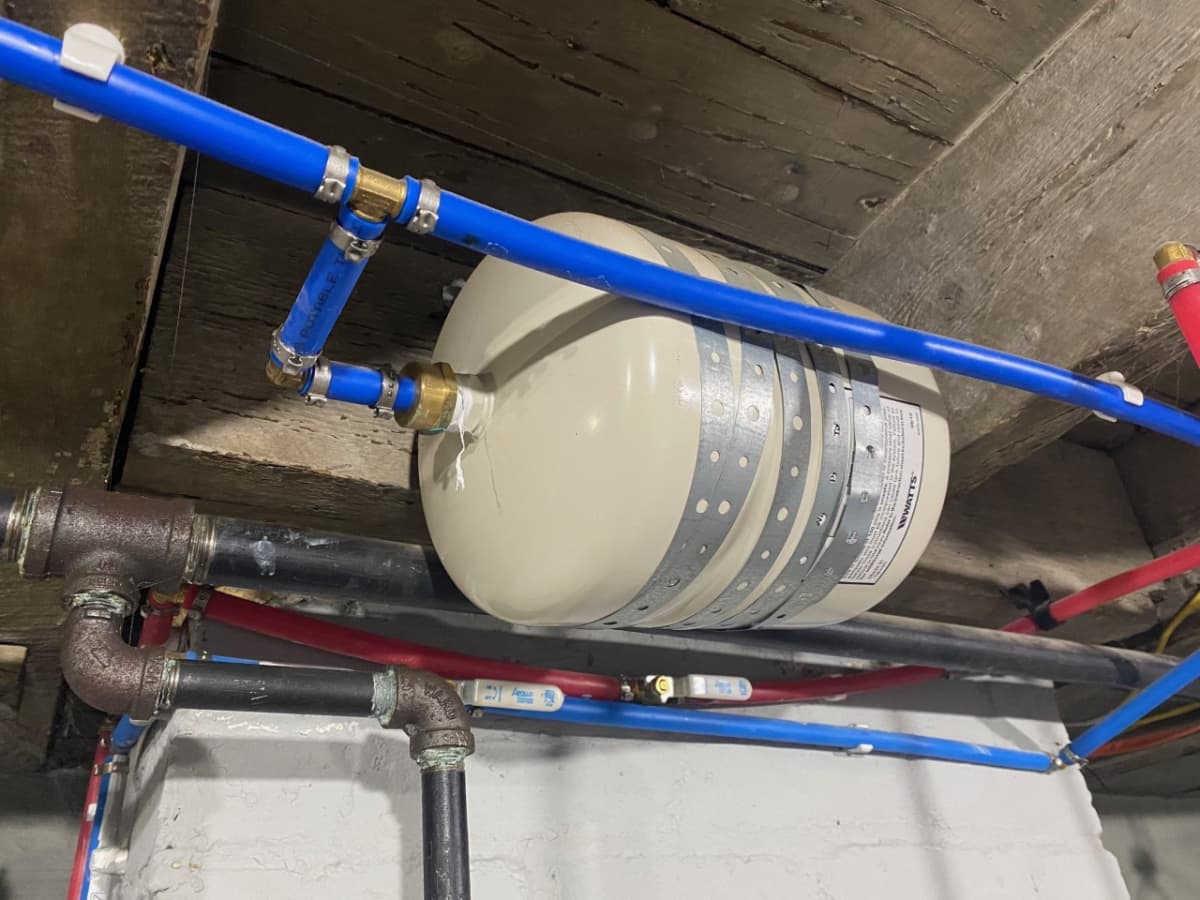The expansion tank for a water heater should be located near the cold water inlet valve. Proper placement of the expansion tank for a water heater is crucial for efficient and safe operation.
Expansion tanks are typically installed near the cold water inlet valve, allowing them to absorb excess pressure caused by the heating and expansion of water within the system. This positioning helps to maintain the proper pressure level in the water heater and prevents potential damage to the system.
By understanding the significance of the expansion tank’s location, homeowners can ensure that their water heater operates effectively and without issues. We will explore more about the importance of the expansion tank and its optimal location in relation to the water heater.

Credit: storables.com
Water Heater Expansion Tank: A Brief Overview
Water heater expansion tanks are crucial components in a plumbing system, designed to alleviate the pressure that builds up within the system as water heats up and expands. Proper placement of the expansion tank is critical for its optimal functioning and longevity of the water heater. Let’s delve into the significance of expansion tanks, their roles in water heater systems, and the importance of proper installation.
Why Is An Expansion Tank Necessary?
Expansion tanks are essential in water heater systems as they help prevent excess pressure buildup. When water is heated, it expands, causing an increase in pressure within the closed water heater system. Without an expansion tank, this pressure can lead to valve leaks, pipe damage, and even water heater failure. By providing a space for the expanded water to move into, the expansion tank helps maintain the system pressure at a safe and consistent level.
The Role Of Expansion Tanks In Water Heater Systems
Expansion tanks function as a buffer against fluctuating pressure, supporting the stability of the water heater system. They absorb the expanded volume of water to prevent pressure spikes that could damage the water heater, pipes, or fixtures. Additionally, expansion tanks contribute to extending the lifespan of the water heater and reducing the frequency of repairs by alleviating stress on the system.
The Importance Of Proper Installation
Proper installation of expansion tanks is paramount to ensure their effectiveness. The location of the expansion tank within the plumbing system is a crucial factor. It should be installed on the cold-water supply line near the water heater, and the connection between the tank and the system should be airtight to prevent air from entering or escaping. This precise placement and installation support optimal functionality and help maintain the integrity of the water heater system.
Understanding Expansion Tank Functionality
Understanding the functionality of an expansion tank in a water heater system is crucial. Expansion tanks are usually located near the water heater and serve to accommodate the expansion of water as it heats up, preventing pressure buildup and potential damage to the system.
Regular maintenance and inspection of the expansion tank’s location can ensure the effective functioning of the water heater system.
Understanding Expansion Tank FunctionalityThe location and functionality of a water heater expansion tank play a crucial role in the efficient performance and longevity of the entire system. Proper understanding of the expansion tank’s functionality is essential for homeowners and professionals alike.Pressure Regulation MechanismThe expansion tank serves as a pressure regulator within the water heating system. When the water inside the heater heats up, it expands, causing a rise in pressure. The expansion tank acts as a buffer to accommodate this increased pressure, preventing it from causing damage to the system. By absorbing excess pressure, the expansion tank helps to stabilize the water heater system, ensuring consistent and safe operation.Effect on Overall System PerformanceWhen the expansion tank is correctly located and functioning, it significantly enhances the overall performance of the water heater system. By maintaining a stable pressure level, the expansion tank helps to reduce strain on the components, leading to improved efficiency and fewer instances of malfunctions. This ultimately contributes to a reliable hot water supply and a more durable water heater system.Impact on Water Heater LongevityThe presence of an expansion tank in the appropriate location can have a direct impact on the longevity of a water heater. By preventing excessive pressure fluctuations, the expansion tank minimizes stress on the internal components, including the tank itself, extending its operational life and reducing the likelihood of premature failures. This not only saves on repair and replacement costs but also ensures a more consistent and reliable hot water supply for an extended period.In summary, the expansion tank’s location and functionality are crucial for regulating pressure, enhancing overall system performance, and prolonging the lifespan of a water heater. Proper understanding and positioning of this component can result in a more efficient and durable water heating system.Determining The Ideal Location
When it comes to installing a water heater expansion tank, determining the ideal location is crucial for its efficient and safe operation. The expansion tank serves as a critical component in a water heater system, alleviating pressure fluctuations and preventing potential damage to the unit. To ensure the expansion tank functions optimally, it’s essential to consider several factors when determining its location.
Influence Of Local Plumbing Codes
Local plumbing codes play a significant role in determining the location for installing a water heater expansion tank. Adhering to these codes ensures compliance with safety standards and regulations, ultimately contributing to the efficient and safe operation of the system. It’s essential to consult and familiarize oneself with the specific requirements outlined in the local plumbing codes to ensure proper placement and installation of the expansion tank.
Proximity To The Water Heater Unit
The proximity of the water heater expansion tank to the water heater unit is a crucial aspect to consider. Placing the expansion tank in close proximity to the water heater unit facilitates efficient pressure management and minimizes the risk of pressure fluctuations in the system. Proximity to the water heater unit also simplifies the installation process and ensures a more streamlined water heating system. When determining the ideal location, prioritize proximity to the water heater unit for optimal function and performance.
Considerations For Indoor And Outdoor Installations
Whether considering an indoor or outdoor installation of the water heater expansion tank, certain considerations should be taken into account. For indoor installations, factors such as available space, ventilation, and proximity to the water heater unit must be considered. On the other hand, outdoor installations require protection from extreme weather conditions and proper shielding from environmental elements. When choosing the location for the expansion tank, consider these specific requirements to ensure a suitable and durable installation, whether indoors or outdoors.
Installation Process And Best Practices
When it comes to the installation process and best practices for water heater expansion tank location, it is crucial to ensure correct placement, seamless connection to the water heater system, and being prepared for potential challenges. The correct installation of the expansion tank not only ensures efficient water heater operation but also extends the lifespan of the system.
Steps For Correct Placement
Properly locating the water heater expansion tank is essential to ensure its optimal function. The following steps should be followed for correct placement:
- Identify a suitable location near the water heater where the expansion tank can be securely mounted.
- Ensure the space is easily accessible for installation and future maintenance.
- Mount the expansion tank in a vertical position to allow for proper air cushion and efficient operation.
Connection To The Water Heater System
Connecting the expansion tank to the water heater system requires careful attention to detail. The following steps should be followed to ensure a secure connection:
- Shut off the water supply to the heater and release any built-up pressure by opening the hot water tap.
- Install a tee fitting on the cold water supply line, following the manufacturer’s instructions and ensuring a watertight seal.
- Connect the expansion tank to the tee fitting and ensure all connections are secure before restoring water supply and pressure to the system.
Potential Challenges And Solutions
During the installation process, several challenges may arise. It is essential to be aware of these potential issues and have solutions at hand:
| Potential Challenges | Solutions |
|---|---|
| The existing water heater system may not have an ideal location for expansion tank installation. | Consider consulting a professional plumber to identify the best alternative location for the expansion tank. |
| Fitting the expansion tank into tight spaces may be challenging. | Opt for compact expansion tank models or consider reconfiguring the space to accommodate the tank. |
Maintenance And Troubleshooting
Proper maintenance and timely troubleshooting of your water heater expansion tank are crucial for ensuring its longevity and efficient operation. By adhering to regular inspection guidelines, addressing common issues, and knowing when to seek professional assistance, you can optimize the performance of your water heater expansion tank.
Regular Inspection Guidelines
- Pressure Check: Periodically test the pressure inside the expansion tank to ensure it’s within the recommended range.
- Visual Examination: Look for signs of corrosion, leakage, or damage to the tank and its connections.
- Valve Inspection: Verify the condition of the pressure relief valve and its proper functionality.
- Support System: Ensure the expansion tank is securely installed and supported to prevent any structural issues.
- Overall Performance: Monitor the overall performance of the water heater system and look for any unusual behavior.
Common Issues And Fixes
- Water Leaks: Address any leaks promptly by tightening connections or replacing damaged components.
- Corrosion: Install a sacrificial anode rod to protect the tank from corrosion and replace it if necessary.
- Excessive Pressure: Adjust the pressure settings or replace the pressure relief valve to regulate the pressure within the desired range.
- Inadequate Expansion: Install a larger expansion tank if the current size is insufficient for the water heater system.
- Sediment Accumulation: Flush the tank to remove sediment buildup and ensure optimal performance.
Professional Assistance And Replacement Considerations
In case of complex issues or if you’re unsure about troubleshooting procedures, it’s advisable to seek professional assistance. Additionally, if the expansion tank shows signs of irreparable damage or malfunctions despite troubleshooting, considering a replacement may be the most cost-effective solution to maintain an efficient water heating system.
Frequently Asked Questions Of Water Heater Expansion Tank Location
Where Should A Water Heater Expansion Tank Be Installed?
The water heater expansion tank should be installed on the cold water supply line. It should be installed either vertically or horizontally, depending on space availability. It should be positioned close to the water heater and before any valves or fixtures.
Where Is My Expansion Tank Located?
The expansion tank is usually located near the boiler or water heater. It helps regulate water pressure.
Does The Expansion Tank Have To Be Above The Water Heater?
Yes, the expansion tank should be above the water heater to function properly. This positioning allows the tank to accommodate thermal expansion effectively. Placing it above the heater ensures efficient operation and prolongs the lifespan of the system.
How Do I Know If My Water Heater Expansion Tank Is Bad?
Signs of a bad water heater expansion tank include waterlogged or corroded tank, water leaks around the tank, and erratic water pressure. Additionally, if you notice water pooling near the tank or hear unusual noises, it may indicate a problem.
Regular maintenance and inspection help detect issues early.
Conclusion
The location of your water heater expansion tank is vital for efficient functioning. It ensures proper pressure relief and safeguards your plumbing system. By placing it in the right spot, you can enhance the longevity and performance of your water heater.
Consider professional installation to maximize its benefits.

